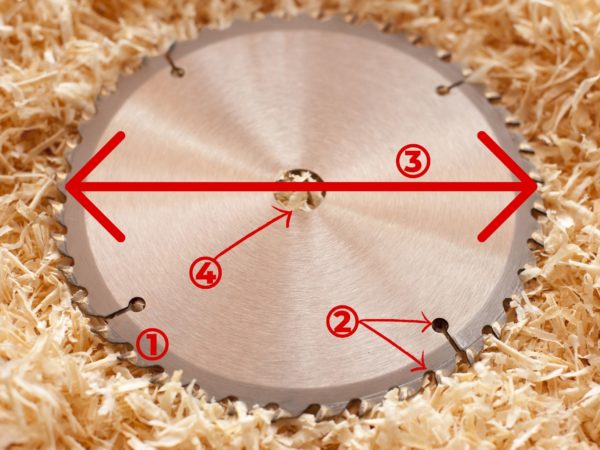It’s confusing when you’re trying to find the best table saw blade in a sea of table saw blades. Know that using the right blade will let you make quicker cuts, and your woodworking will look much better. Finding the right one for your job is easy to do. That’s why I am going to help guide you in finding the perfect table saw blade!
This article is meant for woodworkers who already have a table saw in their shop. If you are still searching for a saw, I am going to point you to an article I wrote on the Top 10 Best Table Saws For Beginners. And if you have a table saw but are still in the learning phase, make sure you look at my article called How To Use A Table Saw.
The best table saw blade will make any of the three most common types of cuts. One cut is called a “rip cut” which is made with the grain. The next is a “cross cut” which goes perpendicular to the grain. For both of these types of cuts get the best bang for your buck and go with the DeWalt 10-Inch Miter/Table Saw Blades combo pack. To make a “dado cut” which is the third type of cut, I recommend using the Freud 6” Pro Dado Set. Just be sure your table saw has an insert that will allow for dado cuts up to ⅝ inch.
Top Picks
Parts Of A Circular Saw Blade
There are some key parts of a circular saw blade that are important to consider when deciding what is the best table saw blade for your needs.

- Cutting Teeth- The cutting teeth are the chisel-like edges that are removing material during a cut.
- Gullet- The gullet is the space between the teeth that moves the sawdust away from the blade during the cut.
- Diameter- The diameter of the saw blade is how wide it is across. There are several different size circular saw blade diameters, and it is important to know which one(s) your saw can handle.
- Arbor Hole- The arbor is the center hole used to attach the blade to the saw motor.
- Kerf- The kerf is the thickness of the blade at its widest point (the cutting teeth). This is also how thick of a groove the blade will leave in the material it is cutting.
Types of Table Saw Blades
Not all table saw blades are created equal. There are several different categories for these blades to fall into. Sometimes there can be some crossover between the categories, but it’s best to use a certain blade for its intended use. The three main categories for table saw blades are crosscuts, rip cuts, and dado cuts.
Crosscut Blades
When you look at a piece of plywood the first thing you notice is the wood grain. If you want to make a cut going perpendicular to the grain you will be making a cross cut. The biggest problem you might run into with these types of cuts is something called “chip out”.
Crosscut blades have 60 teeth or more. The higher the number of teeth, the cleaner the cut will be. Finished carpentry blades have higher numbers of teeth, and give a more precise and cleaner cut.
Rip Cut (Ripping) Blade
Making a rip cut is when you are cutting with the grain. Going in this direction is an easier cut to make, and will end up being cleaner. For this reason a rip cut blade has fewer teeth that are wider and at a more extreme angle. This allows for more material to be taken away during the cut.
Rip cut blades can have between 10 and 30 teeth. A typical rip cut blade will have around 24 teeth.
Combination Blades
A combination is a good general purpose table saw blade. Its teeth count lands between the rip cut and crosscut blades. This is a good option for a diy homeowner who has some weekend wood projects. These blades are not going to have the cleanest crosscut chip out, but will be good for the most part.
Dado Blades
A dado is a groove that has been cut in lumber. They are thick enough to hold the edge of another piece of material, like building a fixed shelf in a bookcase. Since these grooves are thicker than a conventional blade’s kerf, a “stack” of blades are used. This allows you to add or remove blades to get the ideal thickness.
What Kind of Blade Is Best For A Table Saw
The first thing you should ask yourself is what you will be using your table saw for? Are you a home woodworker that wants to make pieces for around the house in your free time? Or are you interested in woodworking for profit, and will need to mass produce products at scale?
If you are a home woodworker, you can generally get by with a good combination blade. This gives you the option of making “good enough” crosscuts or rip cuts with the same blade. I recommend checking out the Diablo 10” Combo Blade (that is if you have a 10 inch table saw).
If you are a woodworker who is interested in making products to sell, consider getting one blade for ripping and one blade for finish cuts. The ripping blade I recommend is the Freud 10” Thin Kerf Rip Cut Blade.
How Many Teeth Should A table Saw blade Have
The answer to this question depends on the blade’s application. The more teeth, the cleaner the cut will be. This is what you want when you need to make a clean cut with little to no chip-out. The teeth count for these types of blades would be 60 and above. The downside to a lot of teeth is they can get gummed up sooner and wind up burning your edges.
If you are ripping your materials you can get away with a lower teeth count. You are less likely to have messy edges when going with the grain than you are with a cross cut. The teeth count for these types of blades can be more in the 24-36 teeth range.
